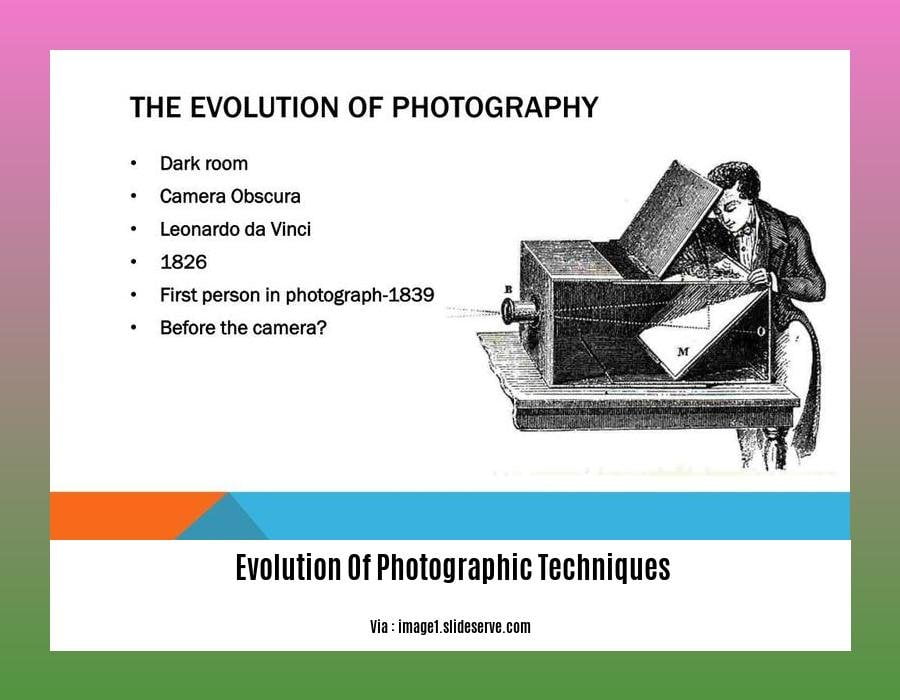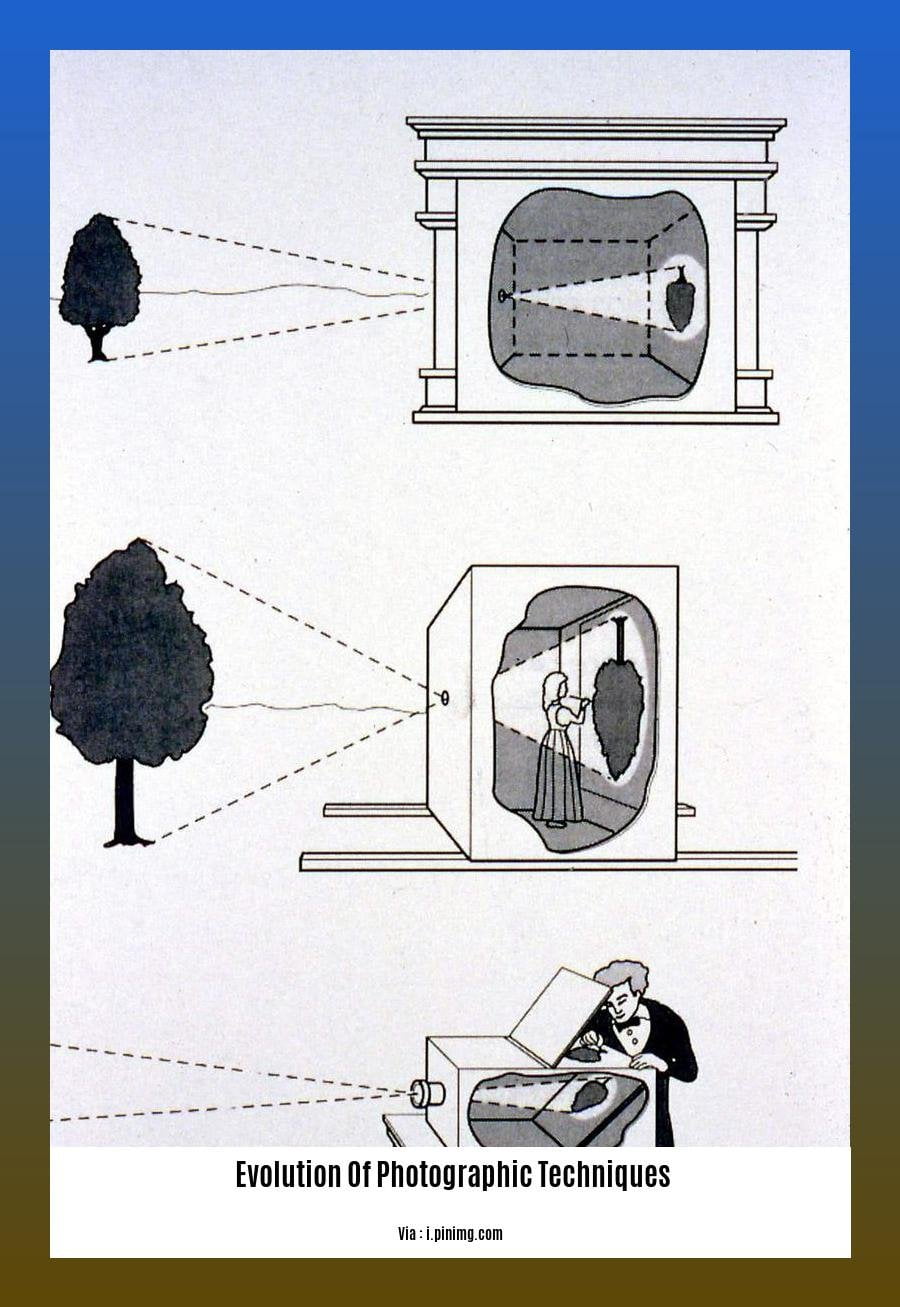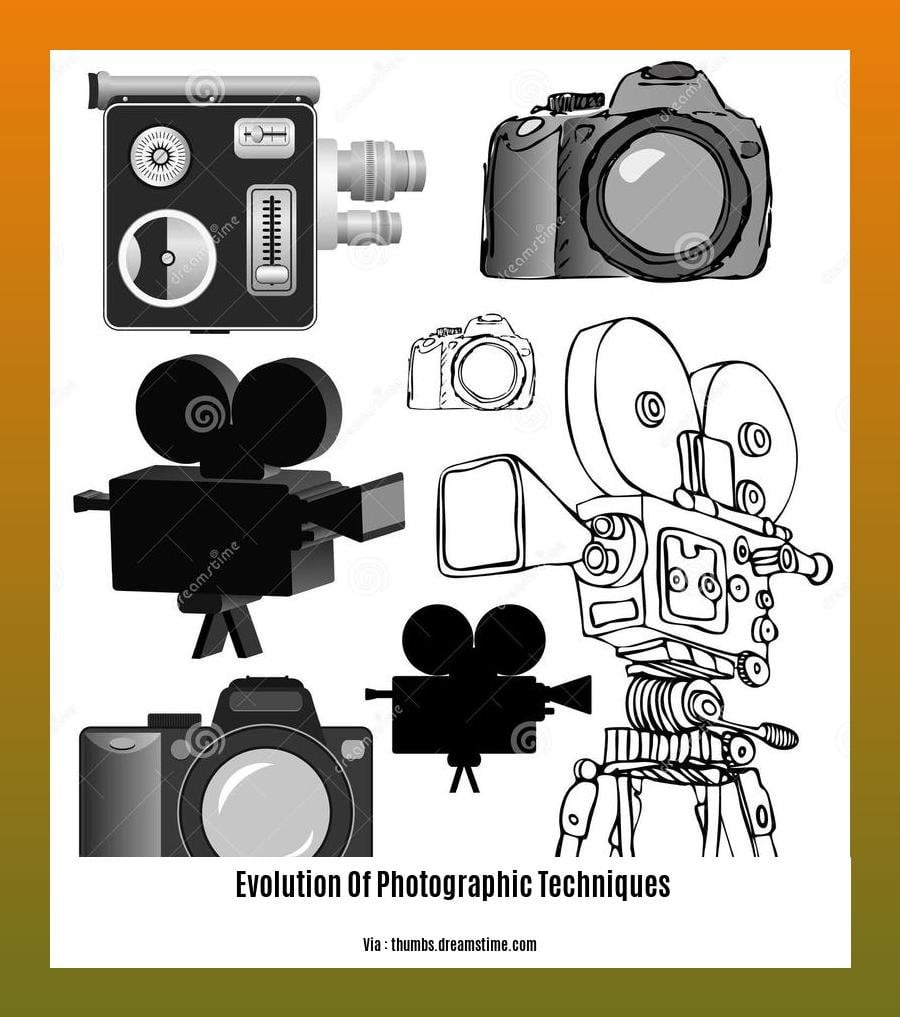Embark on a captivating journey through – The Evolution of Photographic Techniques: A Journey Through Invention and Artistic Expression. Immerse yourself in the extraordinary evolution of photography as we uncover the pioneering techniques and artistic innovations that have shaped the way we capture and share our world.
Key Takeaways:
- Camera obscura, the precursor to the camera, existed in ancient times.
- Daguerreotype was the first successful photographic process, capturing images on silver-coated copper plates.
- Calotype improved upon the Daguerreotype, allowing for multiple copies from a single negative.
- Wet-collodion process enhanced image quality and reduced exposure time.
- Dry plates replaced wet plates, increasing portability and convenience in photography.
The Evolution of Photographic Techniques

As explorers of the visual realm, the journey of evolution of photographic techniques has been nothing short of remarkable. The ability to capture and share impactful moments in history and art has transformed how we see and understand the world.
The advent of the camera obscura in the 5th century B.C. marked the inception of this transformative technology. This simple device projected images onto surfaces, laying the foundation for image creation.
The breakthrough came in 1837 with the Daguerreotype, capturing permanent images on silver-coated copper plates. Its successor, the Calotype, introduced paper negatives, enabling the creation of multiple copies.
Technological advancements continued with the Wet-Collodion Process in 1851, enhancing image quality and reducing exposure time using wet glass plates. Dry Plates followed in 1871-1878, providing portability and convenience to photographers.
The evolution of photographic techniques extended beyond the camera itself, encompassing advancements in lenses, emulsions, and processing methods. The introduction of telephoto and wide-angle lenses expanded the photographer’s field of vision, while the development of color film and digital photography revolutionized the ways in which images could be captured and reproduced.
This technological revolution not only expanded the capabilities of photography but also gave rise to distinct artistic expressions. The Pictorialist Movement embraced soft focus, muted tones, and painterly effects, while the modernist and contemporary movements celebrated abstraction, spontaneity, and conceptual approaches.
Today, the evolution of photographic techniques continues with the rise of digital technologies and computational photography. Algorithms, artificial intelligence, and computer vision are opening up new possibilities for image creation, manipulation, and analysis.
As we navigate the ever-changing landscape of photography, we must appreciate the rich history and rapid technological progress that has brought us to this point. The evolution of photographic techniques is a testament to human ingenuity and the enduring power of images to capture, communicate, and inspire.
Learn about the genesis of photography in this article on the history of photography.
Read the detailed evolution of cameras from the very first one to the more sophisticated ones that we use today in this article about the invention of the camera.
Emergence of Digital Photography
Since the dawn of image-making, we’ve witnessed the remarkable evolution of photographic techniques. In the 21st century, the emergence of digital photography marked a transformative shift, transitioning from analog to digital technologies, revolutionizing how we capture, store, and share visual stories.
Digital Image Creation
Digital images are composed of pixels, tiny squares with distinct color values. These pixels create the rich tapestry of the image, capturing a wide tonal range and dynamic details. Digital cameras employ sensors, the photographic equivalent of our eyes, containing photosites that convert light into electrical signals, generating digital images.
Advantages of Digital Photography
Versatility: Digital photography offers unparalleled versatility in terms of image manipulation, editing, and sharing. Digital images can be easily stored, transferred, and altered using software, enabling photographers to refine and enhance their work.
High Image Quality: Advanced digital cameras capture images with exceptional clarity, color accuracy, and resolution. They can capture a wide dynamic range, preserving details in both bright and shadowy areas.
Reduced Costs: Digital photography eliminates the need for film and processing, significantly reducing the cost of photography. This has democratized the art form, making it more accessible to aspiring photographers and enthusiasts.
Key Takeaways:
- Digital photography emerged in the early 21st century, revolutionizing photography with digital technologies.
- Digital images are composed of pixels, allowing for exceptional image quality and versatility.
- Digital cameras use sensors to convert light into electrical signals, creating digital images.
- Digital photography offers advantages such as cost-effectiveness, ease of editing, and high image quality.
Sources:
- Britannica: History of Photography
- Wex Photo Video: The History and Evolution of Digital Camera Photography
Contemporary Imaging Technologies: Revolutionizing the Art of Photography

Digital photography emerged in the early 21st century, marking a pivotal shift in the world of photography. Digital cameras utilize sensors with photosites that convert light into electrical signals, creating digital images composed of individual pixels with varying color values. This advance enabled a wider tonal range and enhanced dynamic details.
Advanced Imaging Techniques:
- High Dynamic Range (HDR): Captures a wider range of tones, resulting in more realistic and detailed images.
- Artificial Intelligence (AI): Automates image processing, enhancing sharpness, reducing noise, and correcting color balance.
- Computational Photography: Utilizes algorithms to manipulate images, creating unique and expressive effects.
- Virtual Reality (VR) and Augmented Reality (AR): Immersive technologies that create interactive photographic experiences.
Key Impacts of Digital Photography:
- Accessibility: Reduced costs and increased portability made photography more accessible to the masses.
- Image Manipulation: Digital images can be easily edited and manipulated, opening up new creative possibilities.
- Storage and Sharing: Digital formats enable convenient storage and effortless sharing of images online.
- Digital Photography and the Arts: Has had a significant impact on artistic expression, enabling the exploration of new aesthetics and unconventional styles.
Key Takeaways:
- Digital photography revolutionized the photographic landscape, transitioning from analog to digital technologies.
- Contemporary imaging techniques, such as HDR, AI, and computational photography, have expanded the possibilities of image creation and manipulation.
- Digital photography has democratized photography, making it more accessible and fostering creative innovation.
- Emerging technologies, like VR and AR, are shaping the future of immersive photographic experiences.
Relevant Sources:
Artistic and Cultural Impact of Photography
From the moment it emerged, photography has captivated imaginations with its ability to capture the world around us. Beyond its documentary power, photography’s artistic and cultural impact has been transformative, enriching our understanding of ourselves, our surroundings, and our place in history.
Early Influences and Techniques
Photography’s roots lie in the camera obscura, where images were projected onto a screen. In the 1800s, pioneers like Louis Daguerre and William Henry Fox Talbot experimented with light-sensitive materials, ultimately leading to the daguerreotype and calotype processes. These early techniques allowed for the creation of permanent images, revolutionizing art and documentation.
The Pictorialist Movement
In the late 19th century, the Pictorialist movement championed the artistic merits of photography. Practitioners like Alfred Stieglitz and Edward Steichen advocated for soft-focus and painterly effects, blurring the line between painting and photography. Their work challenged traditional notions of photographic realism, elevating the medium to a new level of artistry.
Modernism and the Rise of Abstraction
The 20th century saw the rise of modernism, where photographers embraced abstraction and spontaneity. Man Ray’s solarization techniques and Henri Cartier-Bresson’s candid street photography demonstrated photography’s versatility as an expressive art form. This era also gave rise to photojournalism, capturing historical moments and social issues with raw authenticity.
Digital Transformation and Contemporary Art
The advent of digital photography in the early 21st century ushered in a new era of artistic possibilities. Digital cameras enabled photographers to manipulate and enhance images in ways never before seen. Contemporary artists like Cindy Sherman and Jeff Wall use digital tools to create staged scenes that blur the boundaries between reality and fiction.
Key Takeaways:
- Photography has evolved from a documentary tool to a powerful artistic medium.
- Early techniques and the Pictorialist movement laid the foundation for photography’s artistic legitimacy.
- The 20th century saw the rise of modernism and photojournalism, expanding photography’s expressive range.
- Digital photography has democratized photography and opened up new avenues for artistic exploration.
- Photography continues to shape our cultural landscape, influencing visual arts, literature, and society as a whole.
Sources:
– The Evolution of Photography: A Comprehensive Guide
– The Impact of Technology on Photography
FAQ
Q1: How did digital photography emerge and what impact did it have on the medium?
A1: Digital photography emerged in the early 21st century, replacing analog technologies. It utilizes digital sensors to capture light and convert it into electrical signals, creating digital images. Digital photography transformed the medium, making it easier to capture, edit, and share images.
Q2: What were the key advancements in photographic techniques prior to digital photography?
A2: Prior to digital photography, there were several crucial advancements, including the development of the camera obscura, the Daguerreotype, the Calotype, the Wet-Collodion Process, and Dry Plates. These advancements gradually improved image quality, reduced exposure times, and made photography more portable.
Q3: How has the evolution of photographic techniques impacted the art of photography?
A3: The evolution of photographic techniques has profoundly influenced the art of photography. It allowed photographers to explore new artistic styles and techniques, including abstract, conceptual, and photojournalistic approaches. The shift from analog to digital photography also opened up possibilities for digital manipulation and editing, expanding the creative horizons of photographers.
Q4: What are the advantages of digital photography compared to traditional film photography?
A4: Digital photography offers several advantages over traditional film photography. It provides greater flexibility and control in capturing and editing images, allowing for easy manipulation, cropping, and color correction. Digital photography also allows for immediate viewing and sharing of images, making it more convenient for various applications.
Q5: How has digital photography democratized the art of photography?
A5: Digital photography has democratized the art of photography by making it more accessible to a broader audience. The reduced costs and increased user-friendliness of digital cameras have enabled individuals to capture and share their own stories and perspectives through photography, fostering a wider appreciation and participation in the medium.
- China II Review: Delicious Food & Speedy Service - April 17, 2025
- Understand Virginia’s Flag: History & Debate - April 17, 2025
- Explore Long Island’s Map: Unique Regions & Insights - April 17, 2025
















